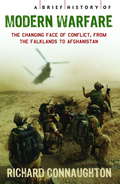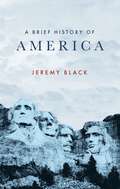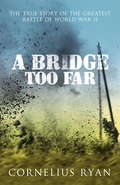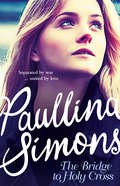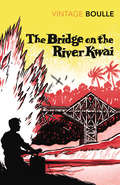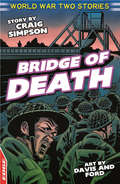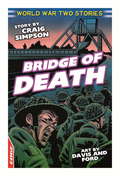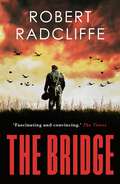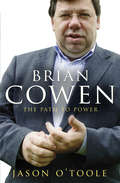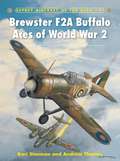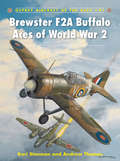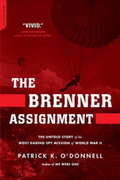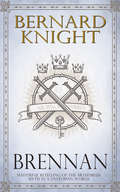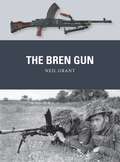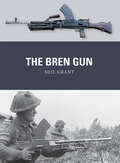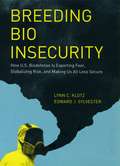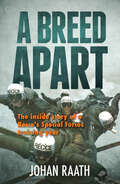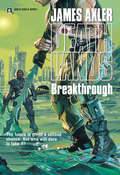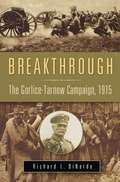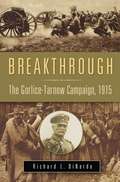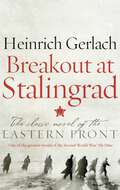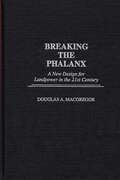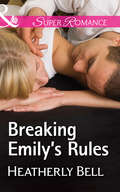- Table View
- List View
A Brief History of Modern Warfare: The changing face of conflict, from the Falklands to Afghanistan (Brief Histories)
by Richard ConnaughtonSince Vietnam, both the way we fight and our reasons for going to war have become much more complex.The importance of a conflict is determined not by its size or by the numbers of combatants involved but by its ripple effects and its influence upon future events. In a series of thrilling recreations of eight of the most significant encounters of the last three decades, military historian Richard Connaughton presents a fascinating insight into modern warfare, including interviews with some of the major figures. The conflicts include Goose Green in the Falklands, the invasion of Grenada, Operation Desert Storm - the first Iraq War, Operations in Mogadishu as immortalized in the book and film Blackhawk Down, the Siege of Gorazde and Operation Barras in Sierra Leone, as well as more recent events at Fallujah, Iraq, and in Helmand Province, Afghanistan. Richard Connaughton has interviewed most of the major figures involved in each of the conflicts and offers powerful insights into why battles either work or don't. This book will tell you what warfare means in the contemporary world and how it can affect tomorrow.
A Brief History of America (Brief Histories)
by Jeremy BlackThe next in this series of admirably concise yet nevertheless comprehensive titles looks at the history of all Americans as well as America; its environmental history and its linkage to economic history; the political shaping of America; and America in the world, from being a colony to post-Cold War America.Black examines the environmental history of America and its linkage to economic history, crucially, the clearing of forests; the spread of agriculture; mineral, coal and iron extraction; industrialisation; urbanisation; and current and growing climate-crisis concerns.He explores the political shaping of America: indigenous American polities; free European and unfree African settlements; the creation of an American State, and its successes and failures from 1783 to 1861; Civil War; democratisation; the rise of the federal Government from the 1930s; the Civil Rights movement from the 1950s onwards, and tensions in more recent governance. The book considers America in the World: as a pre-colonial and colonised space; as a newly-independent power, then a rising international one, the Cold War and the USA as the sole superpower in the post-Cold-War world. These key themes are tackled chronologically for the sake of clarity, beginning with the geological creation of North America, human settlement and native American cultures to 1500; the arrival of Europeans and enslaved Africans to 1770 - the Spanish and French in the Gulf of Mexico and Florida, the English and French, and the Dutch and Swedes further north.The focus then shifts to settler conflicts with native Americans and between European powers leading to a British-dominated North America by 1770. Then the end of European rule and the foundation of an American trans-continental state. The section dealing with the years from 1848 to 1880 looks at the Civil War between North and South, reconstruction and the creation of a new society.Between 1880 and 1920, the United States became an industrial powerhouse and an international power, also a colonial power - the Philippines, Hawaii, Puerto Rico - and a participant in the First World War.The interwar years, 1921 to 1945, brought turmoil: the Roaring Twenties; the growth of Hollywood; Prohibition; jazz; the Great Depression and the New Deal; finally the Second World War. 1945 to 1968 was the American Age, brimming with confidence and success as the world's leading power, but also the ongoing struggle for civil rights. Subsequent years to 1992 brought crisis and recovery: Watergate, the Reagan years and the USA as the sole world superpower.In bringing the book right up to the present day, Black looks at factors that divide American society and economy, though it remains a country of tremendous energy.
A Bridge Too Far: The true story of the Battle of Arnhem
by Cornelius RyanArnhem 1944: the airborne strike for the bridges over the Rhine.The true story of the greatest battle of World War II and the basis of the 1977 film of the same name, directed by Richard Attenborough.The Battle of Arnhem, one of the most dramatic battles of World War II, was as daring as it was ill-fated. It cost the Allies nearly twice as many casualties as D-Day. This is the whole compelling story, told through the vast cast of characters involved. From Dutch civilians to British and American strategists, its scope and ambition is unparalleled, superbly recreating the terror and suspense, the heroism and tragedy of this epic operation.'I know of no other work of literature of World War II as moving, as awesome and as accurate in its portrayal of human courage.' - General James A Gavin
The Bridge to Holy Cross
by Paullina SimonsA powerful story of grief and hope, a passionate and epic love story from the Russian-born author of the internationally bestselling novels TULLY and ROAD TO PARADISE.
The Bridge On The River Kwai
by Pierre BoulleThe Bridge on the River Kwai tells the story of three POWs who endure the hell of the Japanese camps on the Burma-Siam railway - Colonel Nicholson, a man prepared to sacrifice his life but not his dignity; Major Warden, a modest hero, saboteur and deadly killer; Commander Shears, who escaped from hell but was sent back. Ordered by the Japanese to build a bridge, the Colonel refuses, as it is against regulations for officers to work with other ranks. The Japanese give way but, to prove a point of British superiority, construction of the bridge goes ahead - at great cost to the men under Nicholson's command.
Bridge of Death: Bridge Of Death (EDGE: World War Two Short Stories #1)
by Craig SimpsonIt's D-Day, 6th June 1944. Ten minutes after midnight. A small British force is flying over Occupied France on what is virtually a suicide mission - they must capture a bridge before German forces guarding it can blow it up. There's no room for error. They must cast fear aside in this race against time, told from both a British and German perspective. This title is published by Franklin Watts EDGE, which produces a range of books to get children reading with confidence. EDGE - for books kids can't put down.
Bridge of Death: Bridge Of Death (EDGE: World War Two Short Stories)
by Craig SimpsonIt's D-Day, 6th June 1944. Ten minutes after midnight. A small British force is flying over Occupied France on what is virtually a suicide mission - they must capture a bridge before German forces guarding it can blow it up. There's no room for error. They must cast fear aside in this race against time, told from both a British and German perspective. This title is published by Franklin Watts EDGE, which produces a range of books to get children reading with confidence. EDGE - for books kids can't put down.
The Bridge (The Airborne Trilogy #3)
by Robert Radcliffe'A born storyteller' SUNDAY TELEGRAPH. Young paratrooper Theo Trickey has had a remarkable war. Boy soldier, commando, intelligence officer – fighting from northern France to the African desert and in the mountains of Italy. He has already done more than should be asked of any man in war. But D-Day is looming and British intelligence have one more misson for Trickey: to negotiate with his extraordinary old acquaintance, General Erwin Rommel. There are rumours that Germany's greatest general wants to save the Fatherland by any means possible... The Bridge is the final instalment of Radcliffe's Airborne trilogy which tells the extraordinary story of a young soldier, a new regiment and how, together, they changed the course of a war.
Brian Cowen: The Path to Power
by Jason O'TooleMeet Ireland's new Taoiseach, Brian CowenDespite a high profile at the centre of Irish political life for more than twenty years, relatively little is known about our new leader. Just who is Brian Cowen?The story begins in the village of Clara, Co. Offaly, where family, local life and the GAA were formative influences. The sudden and unexpected death of his father, Ber Cowen, Fianna Fáil TD for Laois Offaly, thrust a twenty-four year-old Cowen into the heart of Irish politics. After an eight-year apprenticeship on the back benches, Cowen was appointed to his first ministerial position by Albert Reynolds and later went on to hold the senior cabinet positions of Health, Foreign Affairs and Finance. By the time of Bertie Ahern's resignation, Cowen's standing in the party was such that his election to the leadership of Fianna Fáil seemed inevitable. On 7 May 2008, Brian Cowen became Ireland's eleventh Taoiseach. Here, for the first time, is a portrait of Brian Cowen which follows his remarkable life story, tracing the road to power from early childhood right up to his eventful early months in the office of An Taoiseach.
Brewster F2A Buffalo Aces of World War 2 (Aircraft of the Aces)
by Chris Davey Kari Stenman Andrew ThomasAlthough designed and built for the US Navy, the F2A fought in only one major US engagement, the battle of Midway, in which F2A pilots managed to shoot down a number of Japanese fighters. Soon replaced by the navy, the F2A was exported to Britain, where it was nicknamed the 'Buffalo' thanks to its stubby appearance. The British sent most of these fighters to the Far East where they were used in the defence of Singapore and Malaya. It was in the Winter War, however, that the F2A truly found a home. Calling the plane simply the Brewster, the Finnish flew it against the invading Russians. Overall 37 Finns achieved ace status flying the Brewster, and it was the Finnish fighter of choice until succeeded by the Bf 109 in 1943.
Brewster F2A Buffalo Aces of World War 2 (Aircraft of the Aces #91)
by Kari Stenman Andrew Thomas Mr Chris DaveyAlthough designed and built for the US Navy, the F2A fought in only one major US engagement, the battle of Midway, in which F2A pilots managed to shoot down a number of Japanese fighters. Soon replaced by the navy, the F2A was exported to Britain, where it was nicknamed the 'Buffalo' thanks to its stubby appearance. The British sent most of these fighters to the Far East where they were used in the defence of Singapore and Malaya. It was in the Winter War, however, that the F2A truly found a home. Calling the plane simply the Brewster, the Finnish flew it against the invading Russians. Overall 37 Finns achieved ace status flying the Brewster, and it was the Finnish fighter of choice until succeeded by the Bf 109 in 1943.
The Brenner Assignment: The Untold Story of the Most Daring Spy Mission of World War II
by Patrick K. O'DonnellLike a scene from Where Eagles Dare, a small team of American spies parachutes into Italy behind enemy lines. Their orders: link up with local partisans and sabotage the well-guarded Brenner Pass-the Nazis' crucial supply route through the Alps-thereby bringing the German war effort in Italy to a grinding halt.
The Brenner Assignment: The Untold Story of the Most Daring Spy Mission of World War II
by Patrick K. O'DonnellAn impossible mission Behind enemy lines The never-before-told true story of a small team of American saboteurs with orders to sever the Third Reich's main supply artery -- the Brenner Pass Like a scene from Where Eagles Dare , a small team of American special operatives parachutes into Italy under the noses of thousands of German troops. Their orders: link up with local partisans in the mountains and sabotage the well-guarded Brenner Pass, the crucial route through the Alps for the Nazi war machine. Without the supplies that travel this route, the German war effort in Italy will grind to a halt. Using thousands of recently declassified files, personal interviews, and private documents, including a behind-the-lines diary buried in a bottle, military historian Patrick K. O'Donnell has written a cinematic World War II adventure story. The unforgettable cast of characters includes the dashing and daring team leader; the romantic idealist who plans the operation; the seductive Italian countess who is also a double-agent; and the maniacal SS officer who will stop at nothing to kill the team and their partisan collaborators. The Brenner Assignment is also a World War II story that resonates today, revealing lessons for the war on terror and illustrating the complex nature of insurgency. Packed with action, suspense, intrigue, and even romance, this exciting true tale of survival and sabotage behind enemy lines is one of the greatest untold adventure stories of World War II.
Brennan
by Bernard KnightSet in an alternate version of the early twenty-first century, Brennan is Bernard Knight’s masterful retelling of the Arthurian myth in a dystopian modern world setting.Former soldier Brennan was one of only a few thousand British survivors of a horrific series of international disasters. Five years on, he has become leader of the Welsh survivors as their supplies of food and fuel grow ever more precariously low. However, they face violent competition for these scarce resources from other groups of survivors – and to make things worse, those from other countries are raiding the UK for supplies and killing those who resist.To stand any hope of survival, Brennan must unite the remaining Britons and lead them in resistance against those who would see them dead – but does he stand any hope of succeeding in a world already changed beyond all recognition?
The Bren Gun (Weapon)
by Peter Dennis Neil GrantAdopted in 1938 and remaining in British service until 1991, the popular and reliable Bren was an iconic light machine gun, and arguably the most recognizable Commonwealth weapon of World War ll. Gas-operated and magazine-fed, it was based on a Czech design and was issued in large numbers during and after World War ll, as a section-level automatic weapon. Offering remarkable accuracy for an LMG, the Bren had an effective range of 600 yards, but could reach out to over 1,500 yards. It was generally fired from the prone position using a bipod, but could be fired from the hip when necessary. If kept clean, the Bren gave a reliable service in the harshest of environments, from the deserts of Libya to the Korean mountains in winter. As well as widespread infantry use, the Bren was widely supplied to resistance movements in Occupied Europe. Featuring specially commissioned full-colour artwork and based on meticulous research, this is an engaging story of the iconic light machine gun that equipped British and Commonwealth forces throughout World War II and in a host of postwar conflicts, right up to the Falklands and beyond.
The Bren Gun (Weapon #28)
by Peter Dennis Neil GrantAdopted in 1938 and remaining in British service until 1991, the popular and reliable Bren was an iconic light machine gun, and arguably the most recognizable Commonwealth weapon of World War ll. Gas-operated and magazine-fed, it was based on a Czech design and was issued in large numbers during and after World War ll, as a section-level automatic weapon. Offering remarkable accuracy for an LMG, the Bren had an effective range of 600 yards, but could reach out to over 1,500 yards. It was generally fired from the prone position using a bipod, but could be fired from the hip when necessary. If kept clean, the Bren gave a reliable service in the harshest of environments, from the deserts of Libya to the Korean mountains in winter. As well as widespread infantry use, the Bren was widely supplied to resistance movements in Occupied Europe. Featuring specially commissioned full-colour artwork and based on meticulous research, this is an engaging story of the iconic light machine gun that equipped British and Commonwealth forces throughout World War II and in a host of postwar conflicts, right up to the Falklands and beyond.
Breeding Bio Insecurity: How U.S. Biodefense Is Exporting Fear, Globalizing Risk, and Making Us All Less Secure
by Lynn C. Klotz Edward J. SylvesterIn the years since the 9/11 attacks—and the subsequent lethal anthrax letters—the United States has spent billions of dollars on measures to defend the population against the threat of biological weapons. But as Lynn C. Klotz and Edward J. Sylvester argue forcefully in Breeding Bio Insecurity, all that money and effort hasn’t made us any safer—in fact, it has made us more vulnerable. Breeding Bio Insecurity reveals the mistakes made to this point and lays out the necessary steps to set us on the path toward true biosecurity. The fundamental problem with the current approach, according to the authors, is the danger caused by the sheer size and secrecy of our biodefense effort. Thousands of scientists spread throughout hundreds of locations are now working with lethal bioweapons agents—but their inability to make their work public causes suspicion among our enemies and allies alike, even as the enormous number of laboratories greatly multiplies the inherent risk of deadly accidents or theft. Meanwhile, vital public health needs go unmet because of this new biodefense focus. True biosecurity, the authors argue, will require a multipronged effort based in an understanding of the complexity of the issue, guided by scientific ethics, and watched over by a vigilant citizenry attentive to the difference between fear mongering and true analysis of risk. An impassioned warning that never loses sight of political and scientific reality, Breeding Bio Insecurity is a crucial first step toward meeting the evolving threats of the twenty-first century.
Breeding Bio Insecurity: How U.S. Biodefense Is Exporting Fear, Globalizing Risk, and Making Us All Less Secure
by Lynn C. Klotz Edward J. SylvesterIn the years since the 9/11 attacks—and the subsequent lethal anthrax letters—the United States has spent billions of dollars on measures to defend the population against the threat of biological weapons. But as Lynn C. Klotz and Edward J. Sylvester argue forcefully in Breeding Bio Insecurity, all that money and effort hasn’t made us any safer—in fact, it has made us more vulnerable. Breeding Bio Insecurity reveals the mistakes made to this point and lays out the necessary steps to set us on the path toward true biosecurity. The fundamental problem with the current approach, according to the authors, is the danger caused by the sheer size and secrecy of our biodefense effort. Thousands of scientists spread throughout hundreds of locations are now working with lethal bioweapons agents—but their inability to make their work public causes suspicion among our enemies and allies alike, even as the enormous number of laboratories greatly multiplies the inherent risk of deadly accidents or theft. Meanwhile, vital public health needs go unmet because of this new biodefense focus. True biosecurity, the authors argue, will require a multipronged effort based in an understanding of the complexity of the issue, guided by scientific ethics, and watched over by a vigilant citizenry attentive to the difference between fear mongering and true analysis of risk. An impassioned warning that never loses sight of political and scientific reality, Breeding Bio Insecurity is a crucial first step toward meeting the evolving threats of the twenty-first century.
A Breed Apart: The inside story of a Recce’s Special Forces training year
by Johan RaathOver the years, many have signed up for the South African Special Forces selection course but only a select few have ever passed. The gruelling course pushes recruits to their physical and mental limits.Those who make it through selection still have to complete a demanding year-long training cycle before they can join the ranks of this elite unit. In A Breed Apart, former Special Forces operator Johan Raath offers a rare insider’s view on the training he and other young soldiers received in the mid-1980s. Drawing on the reminiscences of his fellow Recces, he describes the phases of selection and training, and offers valuable insights into what makes a successful operator.The courses in the training cycle show the range and standard of Special Forces training, including weapons handling, bushcraft/survival, parachuting, demolitions and urban warfare, as well as seaborne and riverine operations. For Raath and his cycle buddies, the training cycle culminated in an operation in southern Angola where the young Recces saw action for the first time.Much of what Raath underwent still forms part of present-day Special Forces training. Comprehensive and revealing, this book shows why these soldiers truly are a breed apart.
Breakthrough
by James AxlerMore than a century after a multi-warhead nuclear strike wiped out nearly all of earth's population, humanity's feral instinct to survive has spawned a savage new America. Here, the brutality of man and nature conspire against hope. Yet despite its chaos and bloody turmoil, Deathlands is a second chance for the human race…
Breakthrough: The Gorlice-Tarnow Campaign, 1915 (War, Technology, and History)
by Richard L. DiNardoAn expert on German military history offers the first extensive, English-language study of one of the critical campaigns of World War I.The Eastern Front in World War I has been neglected for too long. Breakthrough: The Gorlice-Tarnow Campaign, 1915 is the first English-language study of the first of the great breakthrough battles of the war—one of the Great War's critical campaigns.The book covers the initial attack of the German Eleventh Army and the Austro-Hungarian Third and Fourth Armies in Galicia as they outflanked the Russian position in the Carpathian Mountains that threatened Hungary. Subsequent chapters cover the retaking of Galicia, including the recapture of Przemysl and Lemberg. The examination concludes with the German and Austro-Hungarian forces under the command of August von Mackensen turning north from Lemberg and the subsequent overrunning of Russian Poland by the Central Powers.
Breakthrough: The Gorlice-Tarnow Campaign, 1915 (War, Technology, and History)
by Richard L. DiNardoAn expert on German military history offers the first extensive, English-language study of one of the critical campaigns of World War I.The Eastern Front in World War I has been neglected for too long. Breakthrough: The Gorlice-Tarnow Campaign, 1915 is the first English-language study of the first of the great breakthrough battles of the war—one of the Great War's critical campaigns.The book covers the initial attack of the German Eleventh Army and the Austro-Hungarian Third and Fourth Armies in Galicia as they outflanked the Russian position in the Carpathian Mountains that threatened Hungary. Subsequent chapters cover the retaking of Galicia, including the recapture of Przemysl and Lemberg. The examination concludes with the German and Austro-Hungarian forces under the command of August von Mackensen turning north from Lemberg and the subsequent overrunning of Russian Poland by the Central Powers.
Breakout at Stalingrad
by Heinrich Gerlach'One of the greatest novels of the Second World War' The Times. 'A remarkable find' Antony Beevor. 'A masterpiece' Mail on Sunday. Stalingrad, November 1942. Lieutenant Breuer dreams of returning home for Christmas. But he and his fellow German soldiers will spend winter in a frozen hell – as snow, ice and relentless Soviet assaults reduce the once-mighty Sixth Army to a diseased and starving rabble. Breakout at Stalingrad is a stark and terrifying portrait of the horrors of war, and a profoundly humane depiction of comradeship in adversity. The book itself has an extraordinary story behind it. Its author fought at Stalingrad and was imprisoned by the Soviets. In captivity, he wrote a novel based on his experiences, which the Soviets confiscated before releasing him. Gerlach resorted to hypnosis to remember his narrative, and in 1957 it was published as The Forsaken Army. Fifty-five years later Carsten Gansel, an academic, came across the original manuscript of Gerlach's novel in a Moscow archive. This first translation into English of Breakout at Stalingrad includes the story of Gansel's sensational discovery.
Breaking the Phalanx: A New Design for Landpower in the 21st Century (Non-ser.)
by Douglas A. MacgregorThis work proposes the reorganization of America's ground forces on the strategic, operational and tactical levels. Central to the proposal is the simple thesis that the U.S. Army must take control of its future by exploiting the emerging revolution in military affairs. The analysis argues that a new Army warfighting organization will not only be more deployable and effective in Joint operations; reorganized information age ground forces will be significantly less expensive to operate, maintain, and modernize than the Army's current Cold War division-based organizations. And while ground forces must be equipped with the newest Institute weapons, new technology will not fulfill its promise of shaping the battlefield to American advantage if new devices are merely grafted on to old organizations that are not specifically designed to exploit them. It is not enough to rely on the infusion of new, expensive technology into the American defense establishment to preserve America's strategic dominance in the next century. The work makes it clear that planes, ships, and missiles cannot do the job of defending America's global security issues alone. The United States must opt for reform and reorganization of the nation's ground forces and avoid repeating Britain's historic mistake of always fielding an effective army just in time to avoid defeat, but too late to deter an aggressor.
Breaking Emily's Rules: The Seal's Return A Perfect Strategy She's Far From Hollywood Breaking Emily's Rules (Heroes of Fortune Valley #1)
by Heatherly BellWeren't rules made to be broken…?
